| |
| |
Photographer,
Location |
Images |
Comments |
|
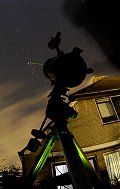
|
Jan Koeman,
Kloetinge, The Netherlands
Nov. 15, 2007 |
#1,
#2, #3,
#4, more |
For more than two weeks we are enjoying the beautiful view of magic fuzzball 17P Holmes from our backyard in the light polluted suburb of our village. Tonight I took a picture of the comet, my telescope and me, pointing with the laserpointer towards Holmes. I was just in time before clouds were covering our clear sky.
|
|

|
David
Moth,
Weymouth, UK
Nov. 14, 2007 |
#1 |
A mosaic of Comet Holmes from the nights of 12/11/07 and 14/11/07 showing :
a) further increase in size and
b) direction of travel towards Mirfak - ie left to right. At current speed the comet should pass very close to Mirfak in about 3 days time.
Images taken with 80mm telephoto zoom and SX MX5C camera - 5 x 3 minutes exposures each.
|
|

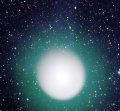
|
Mike Holloway,
Van Buren, AR
Nov. 10, 2007 |
#1,
#2 |
Animation: Images
from Nov. 2,4,5,6,8,9&10. 5x35 second images at about the
same time each night through a blue filter. Images are stacked
on the false center. 5" F4.2 530mm TV127is refractor and
ST10 xmei ccd
Color
photo: This is a RGBL image taken on Nov. 4th. The colors
are varied with the faint blue ion gas being my favorite |
|
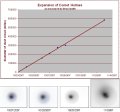
|
Dean Smith,
Grand Forks, ND
Nov. 15, 2007 |
#1,
more |
I imaged Comet Holmes for six nights using an Olympus C-5000 camera afocal with a 9.25" Celestron SCT. I measured the size of the comet in each image and converted it to an actual size in miles using its current distance from Earth. A graph of diameter vs time shows a straight line with a slope of about 50,000 miles/day. The speed of the material would be half this, or about 1000 miles per hour. You can estimate the size of the dust cloud as diameter = (52,000 miles) * (days since Oct 23) This predicts the dust cloud to be bigger than the Sun by Nov 9.
|
|
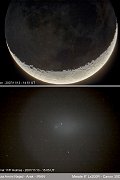
|
Reza Amini Nejad,
Arak, Markazi, Iran
Nov. 13, 2007 |
#1 |
The comet 17/P Holmes is an incredible object yet.I taken those images by Canon 30D and i used the Meade 8" LX200R telescope. Then I edited with Adobe photoshope CS3.this image show that the size of moon and comet Holmes are nearly equal.
|
|

|
Robert
Saint-Jean,
Saint-Bruno, Quebec, Canada
Nov. 13, 2007 |
#1 |
Several
nights, several locations, several telescopes but one beautiful
comet. Canon 300D on SW80ED, C 9 1/4 and LX200 |
|
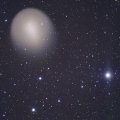
|
Danilo Pivato,
Rome - Italy
Nov. 14, 2007 |
#1,
more |
Shots on the 2007.11.14 - 23h 14m U.T.
Pentax SDUF II 400/4 + ccd ST-10XME Filter:LRGB
exposed: 6x4x60 seconds
The comet is to few more than 1° from Alpha Perseus (Mirfak)
|
|
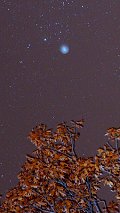
|
Doug Zubenel,
My backyard near De Soto, Kansas.
Nov. 13, 2007 |
#1,
#2 |
Seeing Tom Wagner's image got me to thinking of how colorful our backyard Oak trees are this fall, so I went outside and made this image.
Canon Rebel XTi with a 50mm Nikkor lens @ f/5.6 when focused on the tree during the three seconds it took to open the shutter, fire the flash unit, and cover the lens. Then, the focus was shifted to infinity and the lens opened up to f/2.8, then the lens was uncovered for an additional 15 seconds before closing the shutter. ISO 800.
|
|
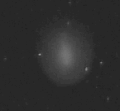
|
Jeanette Dunphy,
From my home near Kilcoy, Queensland, Australia.
Oct. 14, 2007 |
#1,
more |
I was imaging
17P/Holmes when a Taurid meteor went through the field of
view, grazing the edge of the comet. This .gif is only 3
frames long. So happy I was using the Gstar-ex video camera
at the time. |
|
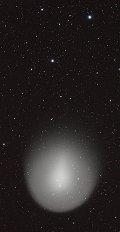
|
John Henley,
Starfield Observatory, Nambour, Queensland, Australia.
Nov. 13, 2007 |
#1,
more |
The comet was photographed through broken cloud just before midnight on November 13. It was ten degrees above the northern horizon. Canon 40D with Williams Optics FLT 110 on Paramount ME, 6 minutes at ISO 800.
|
more
images (Nov. 15-16): from
Simone Bolzoni of Busto Arsizio, Northern Italy; from
Robert Cazilhac of Lugny, France;
more
images (Nov. 13-14): from
Mircea Radutiu of Bucharest, Romania, 'Amiral Vasile Urseanu'
Observatory; from
Ron Wayman of Tampa, Florida; from
David Baldwin of Sussex, England; from
Kyle W. Coker of Laguna Niguel, CA; from
David Strange of Norman Lockyer Observatory, Devon UK; from
Dave Miller of Norton Ohio, USA; from
Lynn Paul of Doylestown, Ohio, USA; from
Sean Davies of Revelstoke, British Columbia, CANADA; from
John Pane of Marshall Township, PA; from
Simone Bolzoni of Busto Arsizio, northern Italy.
more
images (Nov. 11-12): from
Brian Larmay of Coloma Wisconsin; from
Richard Nolthenius of Santa Cruz, California, USA;
more
images (Nov. 9-10): from
Jim Leonard of Inyokern, California;
more
images (Nov. 7-8): from
Giuseppe Petralia of Mont. ETNA (Sicily);
|
|